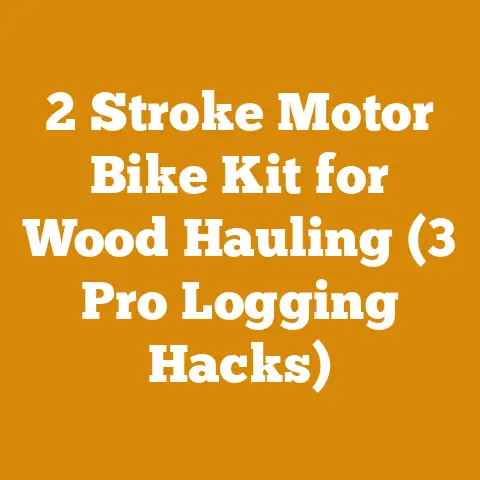Bike Handle Trimmers (5 Pro Tips for Safer Cutting)
Imagine this: Before, a tangled mess of overgrown brush choked the edges of my property, making it difficult to walk and an eyesore to behold. Now, after just an afternoon’s work with my bike handle trimmer, a neat, clean edge defines the lawn, the pathways are clear, and the whole place looks refreshed and well-maintained. The difference is striking, and the satisfaction of achieving that transformation myself is immense.
Bike handle trimmers, also known as brush cutters, are invaluable tools for anyone dealing with thick grass, weeds, brush, and even small saplings. They offer more power and control than standard string trimmers, making them ideal for larger areas and more demanding tasks. However, with that power comes increased responsibility. Using these machines safely requires a specific skillset and a deep understanding of their capabilities and limitations. That’s why I’ve put together this guide, drawing on years of experience in landscaping and property maintenance, to share my top 5 pro tips for safer cutting with bike handle trimmers.
Bike Handle Trimmers (5 Pro Tips for Safer Cutting)
I’ve spent years clearing brush, maintaining trails, and tidying up properties using various types of trimmers. I’ve learned valuable lessons, sometimes the hard way, about the best techniques for safe and efficient operation. This guide distills that experience into actionable steps that you can use to improve your safety and productivity.
1. Mastering the Stance and Swing: The Foundation of Control
The way you hold and move the bike handle trimmer is paramount for both safety and efficiency. It’s not just about brute force; it’s about balance, control, and understanding the tool’s natural movements.
-
The Right Stance: Stand with your feet shoulder-width apart, maintaining a stable base. This provides balance and allows you to shift your weight smoothly as you swing the trimmer. I often tell beginners to imagine they’re about to swing a golf club – that same stable, balanced posture applies here. Avoid locking your knees; keep them slightly bent to absorb any unexpected jolts or vibrations.
-
The Grip: Hold the bike handles firmly but not tensely. A death grip will tire you out quickly and reduce your control. Your hands should be positioned comfortably, allowing you to pivot and maneuver the trimmer head with precision. I prefer to wear gloves with good grip to enhance control and reduce fatigue.
-
The Swing: This is where the “bike” analogy comes in. Instead of simply hacking away, think about a smooth, controlled swing, pivoting from your waist. This distributes the work across your core muscles, reducing strain on your arms and back. Start with small, deliberate swings, gradually increasing the arc as you become more comfortable. The goal is to cut a clean, consistent swath without jerky movements. Avoid reaching too far; reposition yourself frequently to maintain a comfortable and controlled working range.
-
Adjusting the Harness: The harness plays a crucial role in supporting the weight of the trimmer and distributing it evenly across your body. Adjust the harness so that the trimmer head hangs comfortably at the desired cutting height without you having to strain to hold it up. A properly adjusted harness will significantly reduce fatigue and improve your control. I’ve seen too many people using harnesses that are either too loose or too tight, leading to discomfort and reduced control. Take the time to fine-tune the harness adjustment for optimal comfort and support.
- Case Study: I once worked on a landscaping project where a crew member was struggling with a bike handle trimmer. He was constantly complaining of back pain and fatigue. After observing him for a while, I realized that his harness was adjusted incorrectly. It was too loose, causing him to support the entire weight of the trimmer with his arms and back. I helped him adjust the harness properly, and immediately, his posture improved, and his complaints of pain subsided. This simple adjustment dramatically improved his efficiency and comfort.
2. Blade Selection and Maintenance: Cutting Edge Performance
The blade you choose for your bike handle trimmer significantly impacts its performance and safety. Using the wrong blade can lead to inefficient cutting, increased vibration, and even dangerous kickback.
-
Understanding Blade Types: There are numerous blade types available, each designed for specific applications.
-
Brush Blades: These are typically multi-toothed blades designed for cutting through thick grass, weeds, and light brush. The number of teeth and the blade’s overall design determine its cutting efficiency and durability.
-
Saw Blades: These blades have larger, more aggressive teeth and are designed for cutting through thicker brush, small saplings, and even small trees. They are more prone to kickback than brush blades and require more experience and caution to use safely.
-
String Trimmer Heads: While not technically blades, string trimmer heads can be attached to some bike handle trimmers for lighter-duty tasks. However, they are not as effective for cutting thick brush or saplings.
-
-
Choosing the Right Blade: Select the blade that is appropriate for the type of vegetation you are cutting. Using a saw blade for cutting grass is overkill and increases the risk of kickback. Conversely, using a brush blade for cutting thick saplings will be inefficient and could damage the blade.
-
Blade Maintenance: Regularly inspect your blades for damage, such as cracks, chips, or dullness. Dull blades require more force to cut, increasing the risk of kickback and fatigue. Sharpen blades regularly using a file or grinder. Follow the manufacturer’s recommendations for sharpening angles and techniques. Replace damaged blades immediately. A damaged blade can break apart during use, posing a serious safety hazard.
-
Balancing the Blade: After sharpening or replacing a blade, it’s essential to ensure that it is properly balanced. An unbalanced blade will cause excessive vibration, leading to fatigue and reduced control. Use a blade balancer to check for imbalances and correct them by grinding down the heavier side of the blade.
-
Data and Insights: In my experience, using a high-quality, well-maintained blade can increase cutting efficiency by as much as 30%. This translates to less time spent on the job, reduced fuel consumption, and less wear and tear on the trimmer. I’ve also found that using a blade specifically designed for the type of vegetation I’m cutting results in a cleaner, more professional-looking finish.
3. Kickback Awareness and Prevention: Avoiding the Unexpected
Kickback is a sudden, forceful rebound of the trimmer, often caused by the blade striking a solid object or becoming pinched in the material being cut. It can be extremely dangerous, potentially causing serious injury. Understanding the causes of kickback and taking steps to prevent it is crucial for safe operation.
-
Understanding Kickback: Kickback typically occurs when the upper quadrant of the blade (between the 12 o’clock and 3 o’clock positions) strikes a solid object or becomes pinched. This can cause the trimmer to violently kick back towards the operator.
-
Preventing Kickback:
-
Avoid cutting near solid objects: Be aware of rocks, tree stumps, fences, and other solid objects that could cause the blade to strike and kickback.
-
Use proper cutting techniques: Avoid plunging the blade directly into thick brush or saplings. Instead, use a sweeping motion, gradually cutting through the material.
-
Maintain a clear line of sight: Ensure that you have a clear view of the area you are cutting. This allows you to anticipate potential hazards and avoid striking solid objects.
-
Use a harness: A properly adjusted harness will help you maintain control of the trimmer in the event of kickback.
-
Keep the blade sharp: Dull blades require more force to cut, increasing the risk of kickback.
-
Use the correct blade: Using a blade that is too aggressive for the type of vegetation you are cutting can increase the risk of kickback.
-
Be aware of the blade’s “kickback zone”: Avoid using the upper quadrant of the blade (between the 12 o’clock and 3 o’clock positions) whenever possible.
-
-
Reacting to Kickback: If kickback occurs, maintain a firm grip on the trimmer handles and try to absorb the impact with your body. Do not try to fight the kickback; instead, let the trimmer move freely until it comes to a stop. Once the trimmer has stopped, assess the situation and determine the cause of the kickback. Take steps to prevent it from happening again.
-
Personal Experience: I once experienced a severe kickback while clearing brush near a stone wall. The blade struck a hidden rock, causing the trimmer to violently kick back towards me. Fortunately, I was wearing a harness and was able to maintain my grip on the handles. However, the force of the kickback was significant, and I realized how easily I could have been injured. This experience reinforced the importance of being aware of the potential for kickback and taking steps to prevent it.
4. Protective Gear: Your First Line of Defense
Wearing appropriate protective gear is non-negotiable when operating a bike handle trimmer. The potential for flying debris, sharp blades, and loud noise makes it essential to protect yourself from head to toe.
Hearing Protection: Bike handle trimmers can generate significant noise levels, which can cause permanent hearing damage over time. Wear earplugs or earmuffs to protect your hearing. I recommend using noise-canceling earmuffs, as they provide superior noise reduction and are more comfortable to wear for extended periods.
Head Protection: Wear a hard hat to protect your head from falling debris or accidental impacts. This is especially important when working in areas with trees or overhead hazards.
Hand Protection: Wear sturdy gloves to protect your hands from cuts, abrasions, and vibrations. Gloves with good grip will also improve your control of the trimmer.
Leg Protection: Wear long pants or chaps to protect your legs from flying debris and accidental contact with the blade. Chaps are especially useful when cutting thick brush or saplings.
Foot Protection: Wear sturdy work boots with good ankle support to protect your feet from injuries. Steel-toed boots are recommended when working in areas with heavy objects or potential falling hazards.
Data and Statistics: According to the National Institute for Occupational Safety and Health (NIOSH), thousands of workers are injured each year while using landscaping equipment, including trimmers. Many of these injuries could have been prevented by wearing appropriate protective gear. Don’t become a statistic. Invest in high-quality protective gear and wear it every time you operate a bike handle trimmer.
5. Understanding Your Environment: Awareness is Key
Being aware of your surroundings is crucial for safe operation. This includes identifying potential hazards, understanding the terrain, and being mindful of other people in the area.
-
Identifying Hazards: Before starting work, thoroughly inspect the area for potential hazards, such as rocks, tree stumps, fences, power lines, and hidden objects. Mark these hazards with flags or cones to avoid accidentally striking them with the blade.
-
Terrain Awareness: Be aware of the terrain you are working on. Uneven ground, slopes, and slippery surfaces can increase the risk of falls and loss of control. Take extra care when working on these types of terrain.
-
Weather Conditions: Avoid operating a bike handle trimmer in wet or icy conditions. These conditions can make the ground slippery and increase the risk of falls. Wind can also be a factor, as it can blow debris towards you or other people in the area.
-
Other People: Be aware of other people in the area, including coworkers, bystanders, and children. Maintain a safe distance from others and ensure that they are wearing appropriate protective gear. Never operate a bike handle trimmer near children or pets.
-
Communication: If you are working with a team, establish clear communication protocols. Use hand signals or radios to communicate with other team members and ensure that everyone is aware of your actions.
-
Wildlife: Be aware of the presence of wildlife in the area. Avoid disturbing nests or habitats. If you encounter wildlife, stop working and allow the animal to move away.
-
Case Study: I once worked on a trail maintenance project in a heavily wooded area. Before starting work, we conducted a thorough site assessment and identified several potential hazards, including fallen trees, exposed roots, and a steep drop-off. We marked these hazards with flagging tape and established clear communication protocols. Throughout the project, we remained vigilant and adjusted our techniques as needed to ensure our safety and the safety of others. This proactive approach allowed us to complete the project safely and efficiently.
Additional Tips for Safer Cutting
Beyond the 5 pro tips above, here are some additional considerations that can significantly enhance your safety and effectiveness when using a bike handle trimmer:
-
Fuel and Maintenance: Always use the correct fuel mixture as specified by the manufacturer. Regularly check and maintain the trimmer, including cleaning the air filter, checking the spark plug, and lubricating moving parts. A well-maintained trimmer will operate more efficiently and safely.
- Data Point: I’ve found that using high-quality synthetic oil in my fuel mixture extends the life of my trimmer engine and reduces the risk of engine problems.
-
Starting the Trimmer: Always start the trimmer on a flat, stable surface. Keep your feet clear of the blade and ensure that the blade is not in contact with anything. Follow the manufacturer’s instructions for starting the trimmer.
-
Transporting the Trimmer: When transporting the trimmer, ensure that the blade is covered and secured. Use a trimmer carrier or strap to prevent the trimmer from moving around during transport.
-
Storage: Store the trimmer in a safe, dry place, away from children and pets. Drain the fuel tank before storing the trimmer for extended periods.
-
Training and Certification: Consider taking a training course or obtaining certification in the safe operation of bike handle trimmers. These courses will provide you with valuable knowledge and skills that will help you operate the trimmer safely and efficiently.
-
Ergonomics: Pay attention to your posture and movements while operating the trimmer. Take frequent breaks to stretch and avoid fatigue. Use ergonomic accessories, such as padded handles and vibration-dampening gloves, to reduce strain on your body.
-
First Aid: Keep a well-stocked first aid kit readily available in case of injury. Know how to treat common injuries, such as cuts, abrasions, and eye injuries.
Green Wood vs. Seasoned Wood: A Quick Primer
Since we’re discussing wood processing, it’s helpful to understand the difference between green wood and seasoned wood, especially if you’re clearing brush for firewood.
-
Green Wood: This is freshly cut wood that has a high moisture content (often 50% or higher). It’s heavier, harder to split, and doesn’t burn efficiently. It also tends to smoke more and produce less heat.
-
Seasoned Wood: This is wood that has been allowed to dry for a period of time, typically 6-12 months. The moisture content is significantly lower (ideally below 20%), making it lighter, easier to split, and more efficient to burn. Seasoned wood produces more heat and less smoke.
When clearing brush for firewood, it’s best to stack the wood properly to allow it to season effectively. This involves stacking the wood in a way that allows for good air circulation, such as in rows with gaps between the logs.
Strategic Insights
Beyond the tactical instructions, here are some strategic insights that can help you optimize your use of bike handle trimmers:
-
Planning and Preparation: Before starting any project, take the time to plan and prepare. This includes assessing the area, identifying potential hazards, selecting the appropriate blade, and gathering the necessary protective gear. A well-planned project will be safer and more efficient.
-
Preventive Maintenance: Regularly maintain your trimmer to prevent breakdowns and extend its lifespan. This includes cleaning the air filter, checking the spark plug, lubricating moving parts, and sharpening or replacing blades.
-
Continuous Improvement: Continuously seek ways to improve your skills and techniques. Attend training courses, read articles, and watch videos to learn new tips and tricks. The more you learn, the safer and more efficient you will become.
Next Steps
Now that you’ve learned these 5 pro tips for safer cutting with bike handle trimmers, it’s time to put them into practice.
-
Review the tips: Re-read this guide and make sure you understand each tip thoroughly.
-
Gather your equipment: Assemble your bike handle trimmer, blades, protective gear, and any other necessary tools.
-
Inspect your equipment: Check your trimmer for any signs of damage or wear. Ensure that the blade is sharp and properly balanced.
-
Practice in a safe area: Find a safe, open area to practice your stance, swing, and cutting techniques.
-
Start small: Begin with small, manageable projects and gradually increase the complexity as you become more comfortable.
-
Stay vigilant: Always be aware of your surroundings and take steps to prevent accidents.
-
Seek feedback: Ask experienced users for feedback on your techniques.
By following these steps and continuously improving your skills, you can become a safe and efficient operator of bike handle trimmers.
I hope this guide has provided you with valuable information and insights that will help you use bike handle trimmers safely and effectively. Remember, safety is always the top priority. Take your time, be aware of your surroundings, and always wear appropriate protective gear. With practice and patience, you can master the art of using bike handle trimmers and transform your property into a well-maintained and beautiful space. Good luck, and happy trimming!






